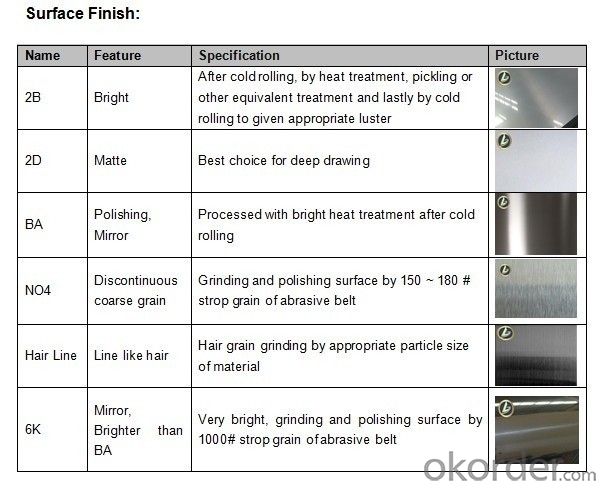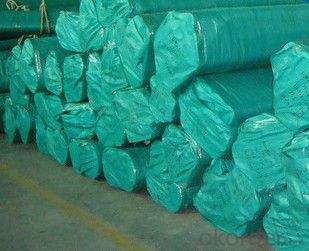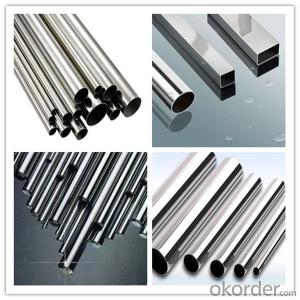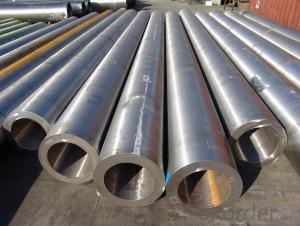304 Stainless Steel Pipe Price with Mill / Slit Edge
- Loading Port:
- Shanghai
- Payment Terms:
- TT OR LC
- Min Order Qty:
- 6 m.t.
- Supply Capability:
- 3000 m.t./month
OKorder Service Pledge
OKorder Financial Service
You Might Also Like
Item specifice
Product Description
Specification of 304 stainless steel pipe price
1. Material: 300series
2. Standard: JIS, AISI, ASTM, GB, DIN, EN
3. Thickness: 0.3-120mm or as customer’s requirement
4. Outer diameter : 0.6 or as customer’s requirement
5. Length:as customer’s requirement
6. Surface: 2B, BA, No.1, etc
7. Technical processing:Welded or Seamless
8. Decoration:
Mirror, No.4, HL NSP, Bead Blast, Vibration,
HL Gold, Mirror Gold, Vibration Gold NSP,
No4 Copper NSP, Mirror Copper, Bead Copper,
HL Brass, Mirror Brass, Bead Brass,
HL Black, Mirror Black, Bead Black NSP,
HL Bronz, Mirror Bronze, Vibration Bronze,
Mirror Etched, HL Etched Copper, Mirror Black Etched, Mirror Etched Gold.

Surface finish of 304 stainless steel pipe price
2B,BA,HL,SB,BK,NO.1,NO.2,NO.4,NO.8,Polish,PVC,Brush,Mirror,Pickled,Annealed etc.

Mechanical property of 304 stainless steel pipe price
| Tensile Strength | σb (MPa)≥520 |
| Offset Yield Strength | σ0.2 (MPa)≥205 |
| Elongation | δ5 (%)≥40 |
| Reduction of Area | ψ (%)≥60 |
| Hardness | ≤187HB;≤90HRB;≤200HV |
| Density(20℃,g/cm3) | 7.93 |
| Melting Point(℃) | 1398~1454 |
| Specific Heat Capacity(0~100℃,KJ·kg-1K-1) | 0.5 |
| Thermal Conductivity(W·m-1·K-1) | (100℃)16.3,(500℃)21.5 |
| Coefficient of Linear Expansion(10-6·K-1) | (0~100℃)17.2,(0~500℃)18.4 |
| Electrical Resistivity(20℃,10-6Ω·m) | 0.73 |
| Longitudinal Modulus of Elasticity(20℃,KN/mm2) | 193 |
Chemical composition of 304 stainless steel pipe price
| 304 | C | Mn | P | S | Si | Cr | Ni |
| % | ≤0.08 | ≤2.00 | ≤0.045 | ≤0.030 | ≤1.00 | 17.5–20.0 | 8.0-11 |
Maintenance of 304 stainless steel pipe price
(1) Regular cleaning and maintenance
(2) Pay attention to prevent the occurrence of the phenomenon of surface scratches
(3) Use soap, weak detergent or warm water to remove surface dust, dirt
(4) In addition to the surface of the binder with alcohol or an organic solvent (ether, benzene)
(5) Use neutral detergent or ammonia solution in addition to surface oil
(6) With 10% nitric acid or abrasive detergent in addition to the surface of the embroider caused by the dirt.
Packaging & Shipping
Packaging way of stainless steel: Original packaging according to your needs. Standard export sea-worthy wooden packing.

Our Services
1.All product are made of high-quality stainless steel sheet;
2.We have good service & short delivery time;
3.We have professional export team;
4.We can provide sample for your evaluation;
5.We can provide Mill test certificate;
6.Your enquiry will get quickly and efficient response.
1)Our products are high quality and best price.
2)We have experience in this line for many years.
3)We have professional team and the factory.
4)It's very important for a company to be honest in the process of trading and so do we.
5)Our products are exported to countries around the world.
- Q:What are the common sizes of stainless steel pipes used in construction?
- The specific application and requirements determine the varying common sizes of stainless steel pipes used in construction. However, numerous construction projects commonly utilize a few standard sizes. These sizes encompass 1/2 inch, 3/4 inch, 1 inch, 1.5 inches, 2 inches, 3 inches, 4 inches, 6 inches, and 8 inches. Distinct purposes are associated with these sizes. For plumbing and water supply systems in residential and commercial buildings, smaller sizes like 1/2 inch, 3/4 inch, and 1 inch are frequently employed. They are also applicable for gas lines and ventilation systems. Larger sizes like 1.5 inches, 2 inches, 3 inches, and 4 inches are predominantly utilized in industrial contexts, including oil and gas pipelines, chemical processing plants, and power generation facilities. These pipes are engineered to accommodate higher flow rates and pressure demands. Moreover, even larger sizes like 6 inches and 8 inches find utility in specialized applications, such as large-scale industrial projects and infrastructure development. Water treatment plants, wastewater treatment facilities, and large-scale irrigation systems often employ these sizes. It is vital to acknowledge that these common sizes represent only a portion of the available options, as numerous other sizes are contingent upon the specific requirements of a construction project. Consultation with a professional engineer or contractor is always advisable to determine the appropriate size of stainless steel pipes for a particular construction endeavor.
- Q:How can the stainless steel tube eliminate stress?
- Or artificial stress, method: stresses both ends of the steel pipe fixed by the mold, through high-frequency shocks, so that the internal stress relief of the steel pipe
- Q:Can stainless steel pipes be used in the aerospace industry?
- Yes, stainless steel pipes can be used in the aerospace industry. Stainless steel is a highly versatile and durable material that offers excellent resistance to corrosion, high temperatures, and pressure. These properties make stainless steel pipes suitable for various applications in the aerospace industry, such as fuel systems, hydraulic systems, and air conditioning systems. Stainless steel pipes are also commonly used in aircraft engines, where they can handle the extreme temperatures and provide reliable performance. Additionally, stainless steel pipes are lightweight compared to other materials, making them ideal for aerospace applications where weight reduction is crucial. Overall, stainless steel pipes meet the stringent requirements and standards of the aerospace industry and are widely used in various aircraft and spacecraft components.
- Q:Can stainless steel pipes be used for swimming pool systems?
- Yes, stainless steel pipes can be used for swimming pool systems. Stainless steel is highly resistant to corrosion, making it an ideal choice for pool applications where exposure to chlorine and other chemicals is common. Additionally, stainless steel pipes offer durability, longevity, and excellent performance in high-temperature environments, making them a reliable option for swimming pool systems.
- Q:What is the average lifespan of stainless steel pipes?
- The average lifespan of stainless steel pipes can vary depending on various factors such as the quality of the materials used, the environment in which they are installed, and the maintenance practices followed. However, on average, stainless steel pipes can last anywhere from 50 to 100 years or more with proper care and maintenance.
- Q:What is the corrosion resistance of stainless steel pipes?
- Stainless steel pipes offer excellent corrosion resistance due to the presence of chromium in their composition. Chromium reacts with oxygen in the atmosphere to form a thin, protective layer of chromium oxide on the surface of the pipe. This oxide layer acts as a barrier, preventing further oxidation and corrosion of the underlying metal. Additionally, stainless steel pipes are often alloyed with other elements such as nickel and molybdenum, which further enhance their corrosion resistance. As a result, stainless steel pipes are highly resistant to rust, pitting, and other forms of corrosion, making them suitable for a wide range of applications in various industries, including plumbing, oil and gas, chemical processing, and marine environments.
- Q:What is the difference between Type 304L and Type 316L stainless steel pipes?
- Type 304L and Type 316L stainless steel pipes are both popular choices for various applications due to their corrosion-resistant properties. However, they differ in their composition and performance in specific environments. The main difference lies in their alloy content. Type 304L stainless steel contains 18-20% chromium and 8-12% nickel, while Type 316L stainless steel contains 16-18% chromium, 10-14% nickel, and 2-3% molybdenum. The addition of molybdenum in Type 316L enhances its resistance to corrosion, particularly in chloride-rich environments. This makes Type 316L more suitable for applications where the pipes will be exposed to seawater, brine, or other aggressive chemicals. Another distinguishing factor is their mechanical properties. Type 316L stainless steel has slightly higher tensile strength and yield strength compared to Type 304L. It also exhibits better creep and stress rupture properties, making it more suitable for high-temperature applications. However, Type 304L is still a good choice for most general-purpose applications and offers excellent durability and longevity. In terms of cost, Type 316L stainless steel pipes are generally more expensive than Type 304L due to the added alloying elements. Therefore, the choice between the two will depend on the specific requirements of the application, considering factors such as the corrosive environment, temperature, and budget. Overall, while both Type 304L and Type 316L stainless steel pipes offer excellent corrosion resistance, Type 316L provides superior performance in more aggressive environments and higher temperatures. It is important to consult with a materials expert or engineer to determine the most suitable stainless steel pipe for a specific application.
- Q:What is the difference between 304J8 and 316J8 stainless steel pipes?
- The primary distinction between stainless steel pipes of 304J8 and 316J8 lies in their composition and particular characteristics. 304J8 stainless steel, a widely utilized grade, is renowned for its exceptional resistance to corrosion, particularly in acidic and chloride environments. It boasts a higher chromium content (approximately 18-20%) and nickel content (around 8-10.5%), which contribute to its durability and resistance to corrosion. This grade finds suitability in various applications such as food processing, chemical industries, and architectural structures. On the contrary, 316J8 stainless steel represents an upgraded version of 304J8, featuring additional alloying elements. It possesses a higher chromium content (around 16-18%), nickel content (approximately 10-14%), and molybdenum content (around 2-3%). The introduction of molybdenum enhances its resistance against pitting and crevice corrosion, making it especially appropriate for marine environments or areas exposed to high chloride levels. As a result, 316J8 stainless steel pipes are commonly employed in seawater applications, chemical processing plants, and coastal structures. To summarize, the primary distinction between 304J8 and 316J8 stainless steel pipes is the inclusion of molybdenum in the latter, which imparts superior resistance to pitting and chloride corrosion. While both grades offer excellent corrosion resistance, the choice between them depends on the specific environment and application requirements.
- Q:Classification, advantages and disadvantages of stainless steel welding
- The arc is produced between the tungsten welding wire and the workpiece, so the protection gas is pure argon and the welding wire is not charged, so it can be sent by hand or by machine. Then it is whether to use direct current or alternating current, depending on the welding material.
- Q:How do you prevent oxidation in stainless steel pipes?
- Preventing oxidation in stainless steel pipes can be achieved through several methods. One way to effectively prevent oxidation is by applying a protective coating or finish on the surface of the pipes. Various types of coatings, including paints, epoxy, or polyurethane, can serve as barriers that prevent oxygen from coming into contact with the stainless steel, thus reducing the risk of oxidation. Furthermore, keeping the pipes clean and well-maintained is crucial in preventing oxidation. It is essential to eliminate any accumulated dirt, debris, or corrosive substances from the surface of the pipes. This can be accomplished using mild detergents or specialized cleaning agents specifically designed for stainless steel. Ensuring proper ventilation in the installation area is another preventive measure. Sufficient ventilation helps minimize the presence of moisture or humidity, which can accelerate the oxidation process. Additionally, keeping the pipes dry and avoiding prolonged exposure to water or moisture is vital in preventing oxidation. Lastly, selecting the appropriate grade of stainless steel for the intended application is important. Different grades of stainless steel offer varying levels of resistance to oxidation. For instance, austenitic stainless steel grades like 304 and 316 are highly resistant to oxidation and are commonly used in applications where corrosion resistance is crucial. In conclusion, employing a combination of preventive measures, such as protective coatings, regular cleaning, proper ventilation, and selecting the appropriate stainless steel grade, can effectively prevent oxidation in stainless steel pipes.
1. Manufacturer Overview |
|
|---|---|
| Location | |
| Year Established | |
| Annual Output Value | |
| Main Markets | |
| Company Certifications | |
2. Manufacturer Certificates |
|
|---|---|
| a) Certification Name | |
| Range | |
| Reference | |
| Validity Period | |
3. Manufacturer Capability |
|
|---|---|
| a)Trade Capacity | |
| Nearest Port | |
| Export Percentage | |
| No.of Employees in Trade Department | |
| Language Spoken: | |
| b)Factory Information | |
| Factory Size: | |
| No. of Production Lines | |
| Contract Manufacturing | |
| Product Price Range | |
Send your message to us
304 Stainless Steel Pipe Price with Mill / Slit Edge
- Loading Port:
- Shanghai
- Payment Terms:
- TT OR LC
- Min Order Qty:
- 6 m.t.
- Supply Capability:
- 3000 m.t./month
OKorder Service Pledge
OKorder Financial Service
Similar products
New products
Hot products
Hot Searches
Related keywords



























